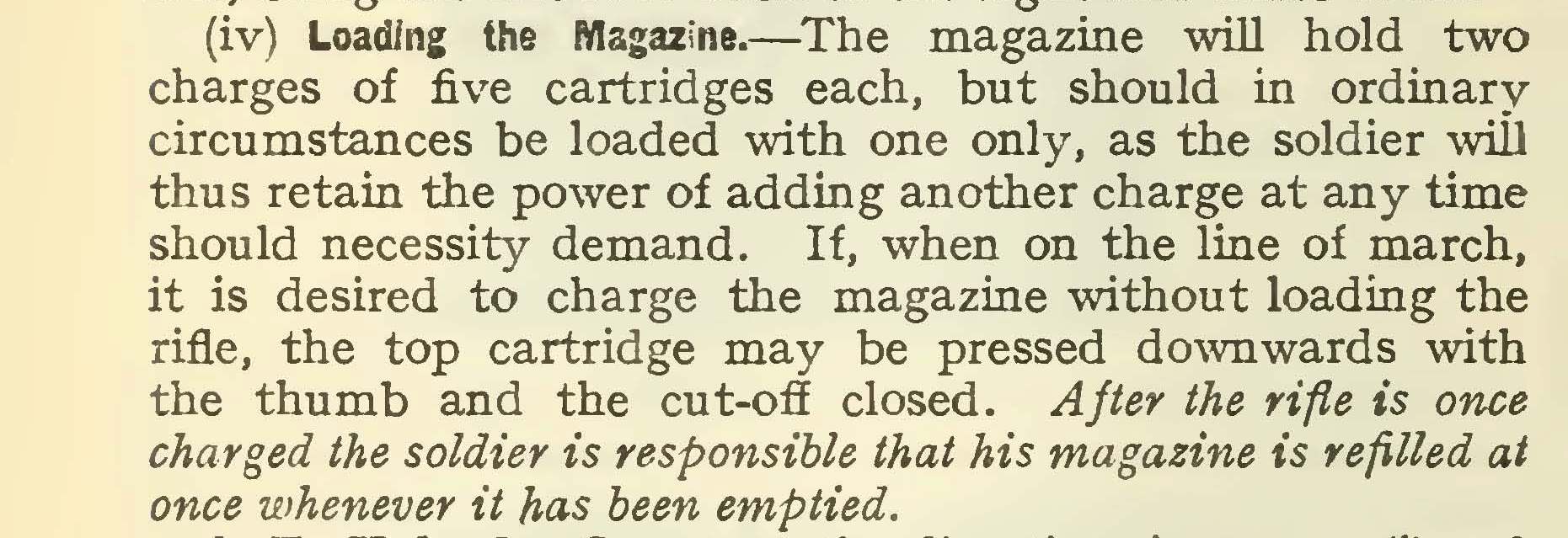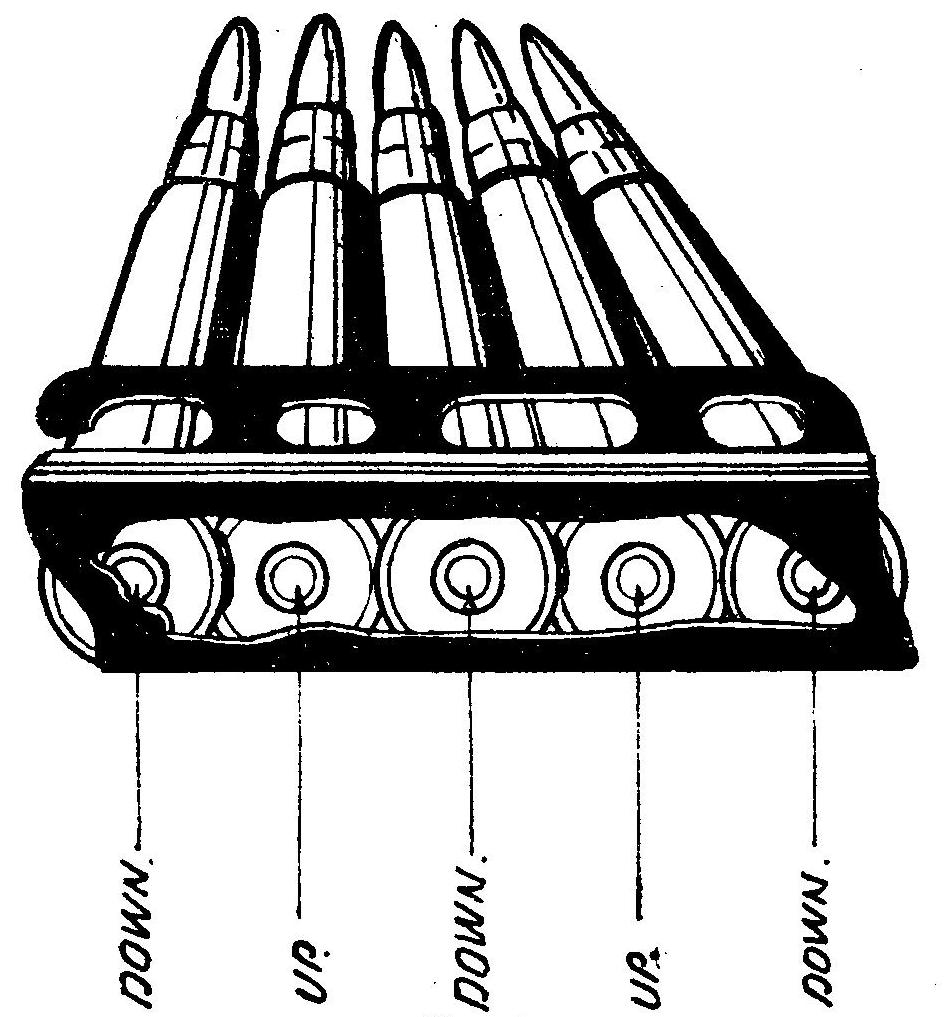This is a bit of a hot topic on which everybody seems to have an opinion.
They are not called 'Stripper Clips', they are called 'Chargers Clips', that is why the Charger bridge on the rifle is so called and why early members of the Enfield family were referred to as 'Charger Loaded'.
|
This is the correct way to load the rounds into the charger; The reason for putting the rounds into the charger in this way is that it then makes no difference at all which way up you hold it when charging the magazine. This is important as, of course, none of us look at the rifle or the charger when reloading do we? No, much too busy watching where the target went. Alternatively, if it's dark you can't see which way up the thing is. We know, we don't do much shooting on the old western front these days, and we don't do night shoots at Bisley, but this is why and how they were designed to be used, and it remains the best way of doing things. And it works. |
|
You can, we must admit, load them in any way you like if you are charging an empty rifle, the magazine is so well designed that even the most inept shooter would have difficulty getting it wrong (that is not a challenge, we are sure that if you try hard enough, it is possible).
As you push the rounds into the magazine they all change position as if by magic, so that they now all sit on top of one another with the rim of each round in front of the one below it, so you don't get a jammed magazine or rim-lock.
This isn't really magic of course, it is design and engineering. The shape of the platform and the way the spring is attached make the back of the platform easier to depress than the rear, the charger bridge is also set slightly forward of the back of the mag, this means the rounds both; slide backwards, and tip up at the front. So the cartridge rims don't get caught on each other.
(If the platform in your magazine can be easily depressed at the front then you either need a new spring in it or the tabs on the platform are bent and need attention, otherwise you will get jams).
When you put the first 5 rounds in, there is plenty of room for the platform to go down into the mag, and it is this movement that ensures they all end up in the correct position.
But if there are already 5 rounds in there, then there is less movement and things can (and often do) go horribly wrong.
Which brings us to the problem bit, the second clip (or charger).
First a bit of history. The British army got a horrible shock and a very bloody nose when they first met the Boers, but they learned from the experience and if you read "Musketry Regulations Part 1 (1909)" you will probably be surprised at the level of technical detail it goes into and just how thoroughly well trained the ordinary British soldier was by 1914.
The tests which each soldier had to pass each year and which determined his level of pay (and that of his officers would you believe) were not just of marksmanship, they were also timed. And so weapon handling was a crucial element of training, and seems to have been practiced constantly. Loading and Reloading was possibly the most important part, as a soldier with an empty rifle in close proximity to an enemy soldier with a loaded rifle very quickly ceases to have any effect on the outcome of the battle.
To reduce the occurrence of this unfortunate event the army provided the British soldier with a rifle that had a big advantage over many of it's continental counterparts. You could, at any convenient time, top up your rifle with an additional 5 rounds.
It states in "Musketry Regulations Part 1 (1909 - revised 1914)" at the bottom of page 93:

This is how it was intended to be used, and this is how the British soldier of the time used it.
Also in:
Musketry, Elementary Training. 1915 (ed; Capt J Solano)
PREFACE: NOTES ON EXPERIENCE GAINED AT THE FRONT.
By General Sir O'Moore Creagh, V.C
We find, at page xii:

And later in that book, Captain J Solano, simply repeated the same lines from Musketry Regulations Part 1.

17 years later we find this in the manual:
Small Arms Training. Volume I. Pamphlet No 3. RIFLE (1937)
Lesson 3. Loading and Unloading.
Para 6: Charging magazine.
i; Magazine holds two chargers, each of 5 rounds, but should generally only be loaded with one.
And finally, just to bang it home. Let's have a look at the latest and most assuredly final operating manual for the Lee Enfield, printed in 1991 by the Canadian Army (in both English and French of course).

So, how do you load 10 rounds into the magazine from a charger in such a way as to be quite sure you won't get a jam?
Quite simply, you can't, it will often work most of the time, but the one time it doesn't will likely be very frustrating (usually during a competition). The only way to be sure that rounds 1 and 5 (it is always them) don't jam solid when you push the bolt forward is to load the last 5 rounds by hand.
The bottom line is, it was never (generally) meant to be used like that, so why do we do it?
Every match we start off with 10 rounds in the mag, and every match someone gets a jam (unless they loaded by hand).
Take a look at the table of classification practices at the beginning of the article on this site which looks at "The Mad Minute", and you will see that every practice was with 5 rounds.
I am quite sure that the response from an old school firearms instructor at Hythe would be that "If God or the Army had meant you to put 10 rounds in the magazine you would have a 10 round charger clip".
You can find more information in the Armourers Notes 1943 which is in the books & publications section of the forum (It's on page 9 "A.C.I. 8080, 1943".
It comes from an addendum to "Armourers Notes 1931" I believe, and was published after the No4 was introduced in order to update it.

This relates to the No4 Mk1 of course. It does explain why you can't load 10 rounds on some rifles, though it implies that loading with 10 was the norm in 1942.
It would appear that the training manuals from 1942 onwards make no mention of the 5 round rule. But then there was a war on, the manuals are a lot shorter and the object would have been to turn raw recruits into soldiers as fast as possible.


